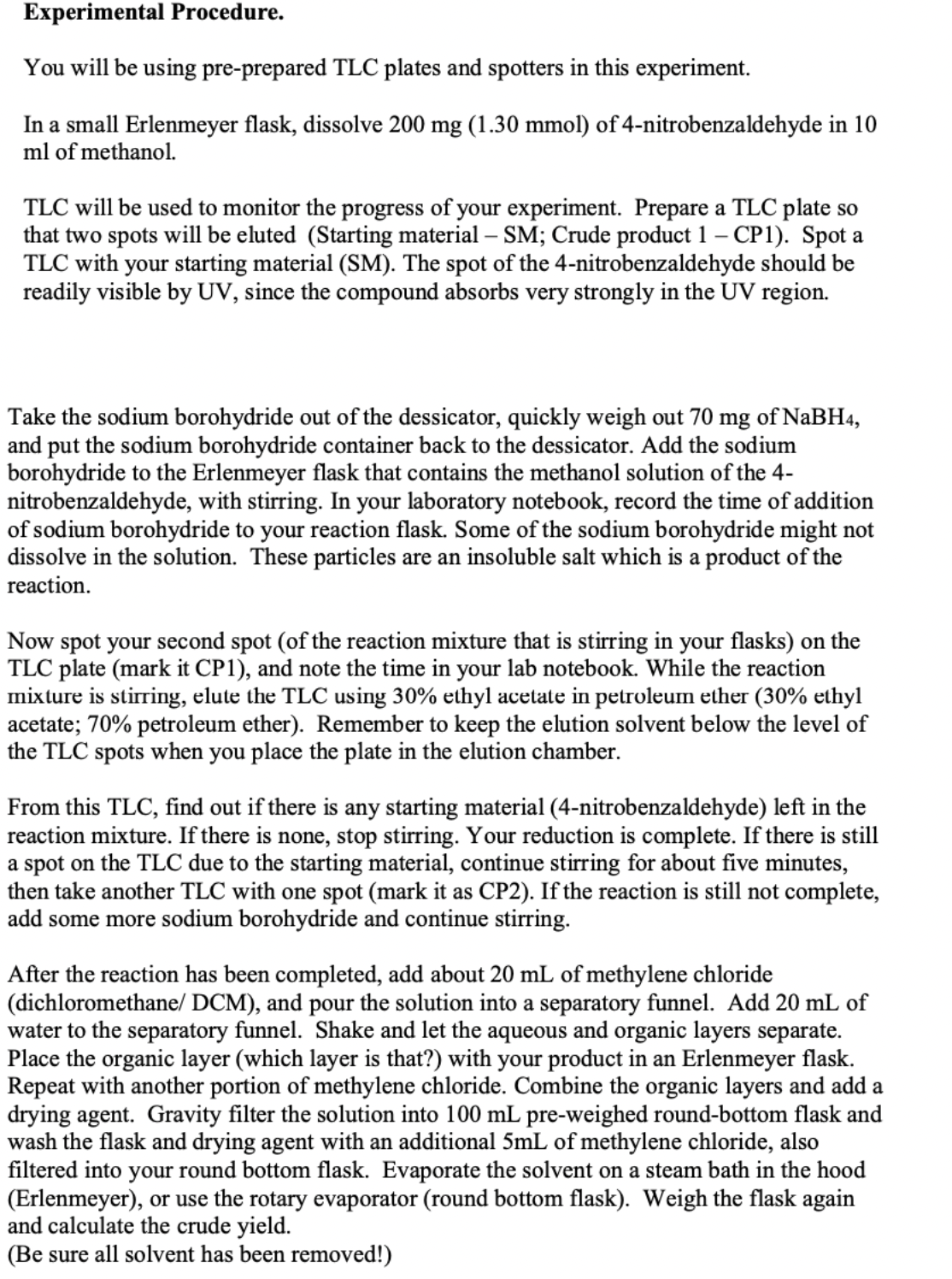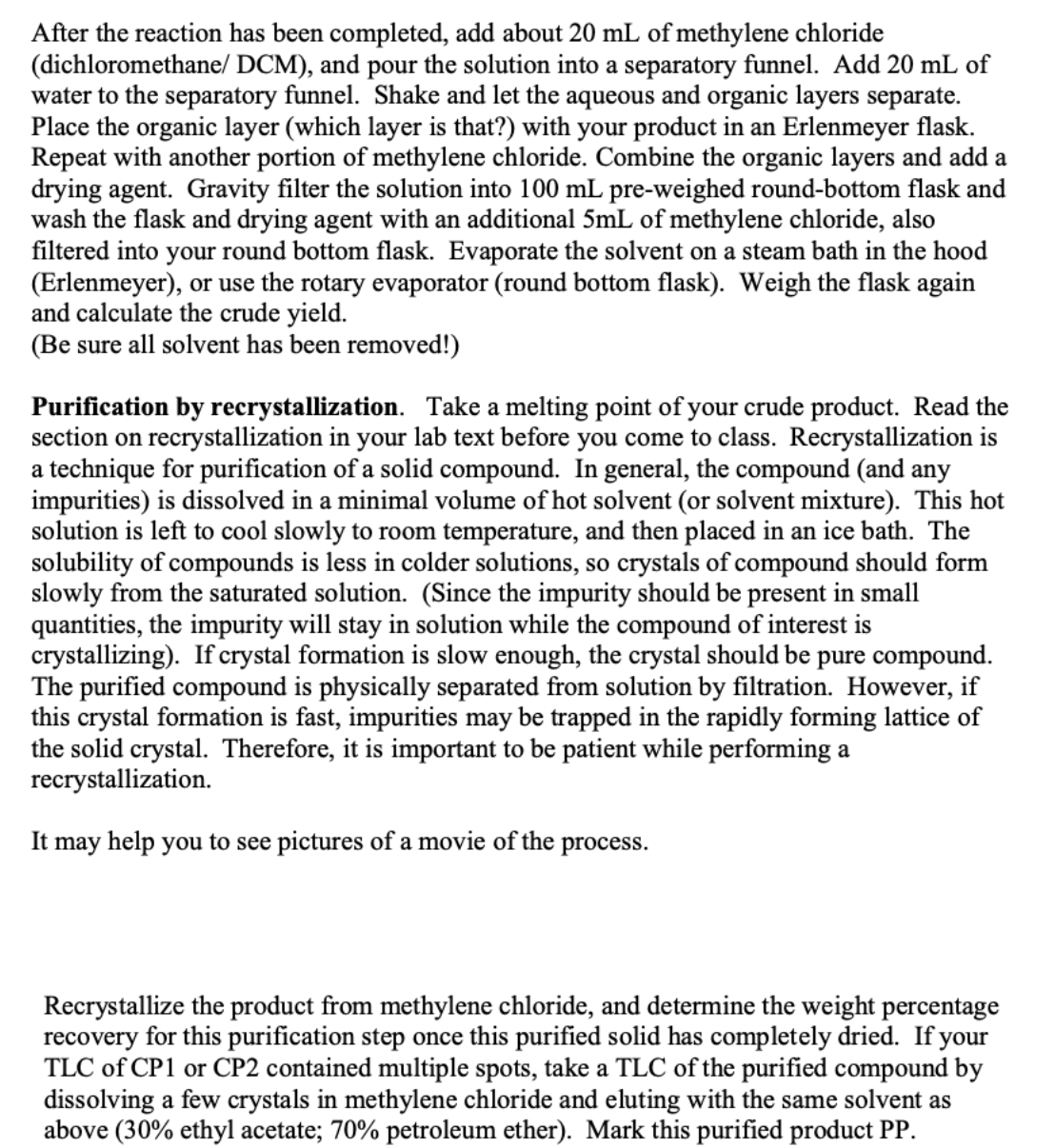Chapter89: Thin-layer Chromatography
Section: Chapter Questions
Problem 5P
Related questions
Question
I need to get the rf valuse from a made up value and draw a tlc plate of 30% ethyl actate and 70% peterloume ether

Transcribed Image Text:Experimental Procedure.
You will be using pre-prepared TLC plates and spotters in this experiment.
In a small Erlenmeyer flask, dissolve 200 mg (1.30 mmol) of 4-nitrobenzaldehyde in 10
ml of methanol.
TLC will be used to monitor the progress of your experiment. Prepare a TLC plate so
that two spots will be eluted (Starting material – SM; Crude product 1 – CP1). Spot a
TLC with your starting material (SM). The spot of the 4-nitrobenzaldehyde should be
readily visible by UV, since the compound absorbs very strongly in the UV region.
Take the sodium borohydride out of the dessicator, quickly weigh out 70 mg of NaBH4,
and put the sodium borohydride container back to the dessicator. Add the sodium
borohydride to the Erlenmeyer flask that contains the methanol solution of the 4-
nitrobenzaldehyde, with stirring. In your laboratory notebook, record the time of addition
of sodium borohydride to your reaction flask. Some of the sodium borohydride might not
dissolve in the solution. These particles are an insoluble salt which is a product of the
reaction.
Now spot your second spot (of the reaction mixture that is stirring in your flasks) on the
TLC plate (mark it CP1), and note the time in your lab notebook. While the reaction
mixture is stirring, elute the TLC using 30% ethyl acetate in petroleum ether (30% ethyl
acetate; 70% petroleum ether). Remember to keep the elution solvent below the level of
the TLC spots when you place the plate in the elution chamber.
From this TLC, find out if there is any starting material (4-nitrobenzaldehyde) left in the
reaction mixture. If there is none, stop stirring. Your reduction is complete. If there is still
a spot on the TLC due to the starting material, continue stirring for about five minutes,
then take another TLC with one spot (mark it as CP2). If the reaction is still not complete,
add some more sodium borohydride and continue stirring.
After the reaction has been completed, add about 20 mL of methylene chloride
(dichloromethane/ DCM), and pour the solution into a separatory funnel. Add 20 mL of
water to the separatory funnel. Shake and let the aqueous and organic layers separate.
Place the organic layer (which layer is that?) with your product in an Erlenmeyer flask.
Repeat with another portion of methylene chloride. Combine the organic layers and add a
drying agent. Gravity filter the solution into 100 mL pre-weighed round-bottom flask and
wash the flask and drying agent with an additional 5mL of methylene chloride, also
filtered into your round bottom flask. Evaporate the solvent on a steam bath in the hood
(Erlenmeyer), or use the rotary evaporator (round bottom flask). Weigh the flask again
and calculate the crude yield.
(Be sure all solvent has been removed!)

Transcribed Image Text:After the reaction has been completed, add about 20 mL of methylene chloride
(dichloromethane/ DCM), and pour the solution into a separatory funnel. Add 20 mL of
water to the separatory funnel. Shake and let the aqueous and organic layers separate.
Place the organic layer (which layer is that?) with your product in an Erlenmeyer flask.
Repeat with another portion of methylene chloride. Combine the organic layers and add a
drying agent. Gravity filter the solution into 100 mL pre-weighed round-bottom flask and
wash the flask and drying agent with an additional 5mL of methylene chloride, also
filtered into your round bottom flask. Evaporate the solvent on a steam bath in the hood
(Erlenmeyer), or use the rotary evaporator (round bottom flask). Weigh the flask again
and calculate the crude yield.
(Be sure all solvent has been removed!)
Purification by recrystallization. Take a melting point of your crude product. Read the
section on recrystallization in your lab text before you come to class. Recrystallization is
a technique for purification of a solid compound. In general, the compound (and any
impurities) is dissolved in a minimal volume of hot solvent (or solvent mixture). This hot
solution is left to cool slowly to room temperature, and then placed in an ice bath. The
solubility of compounds is less in colder solutions, so crystals of compound should form
slowly from the saturated solution. (Since the impurity should be present in small
quantities, the impurity will stay in solution while the compound of interest is
crystallizing). If crystal formation is slow enough, the crystal should be pure compound.
The purified compound is physically separated from solution by filtration. However, if
this crystal formation is fast, impurities may be trapped in the rapidly forming lattice of
the solid crystal. Therefore, it is important to be patient while performing a
recrystallization.
It may help you to see pictures of a movie of the
process.
Recrystallize the product from methylene chloride, and determine the weight percentage
recovery for this purification step once this purified solid has completely dried. If your
TLC of CP1 or CP2 contained multiple spots, take a TLC of the purified compound by
dissolving a few crystals in methylene chloride and eluting with the same solvent as
above (30% ethyl acetate; 70% petroleum ether). Mark this purified product PP.
Expert Solution
This question has been solved!
Explore an expertly crafted, step-by-step solution for a thorough understanding of key concepts.
Step by step
Solved in 3 steps with 1 images

Knowledge Booster
Learn more about
Need a deep-dive on the concept behind this application? Look no further. Learn more about this topic, chemistry and related others by exploring similar questions and additional content below.Recommended textbooks for you

EBK A SMALL SCALE APPROACH TO ORGANIC L
Chemistry
ISBN:
9781305446021
Author:
Lampman
Publisher:
CENGAGE LEARNING - CONSIGNMENT

Organic Chemistry: A Guided Inquiry
Chemistry
ISBN:
9780618974122
Author:
Andrei Straumanis
Publisher:
Cengage Learning

EBK A SMALL SCALE APPROACH TO ORGANIC L
Chemistry
ISBN:
9781305446021
Author:
Lampman
Publisher:
CENGAGE LEARNING - CONSIGNMENT

Organic Chemistry: A Guided Inquiry
Chemistry
ISBN:
9780618974122
Author:
Andrei Straumanis
Publisher:
Cengage Learning